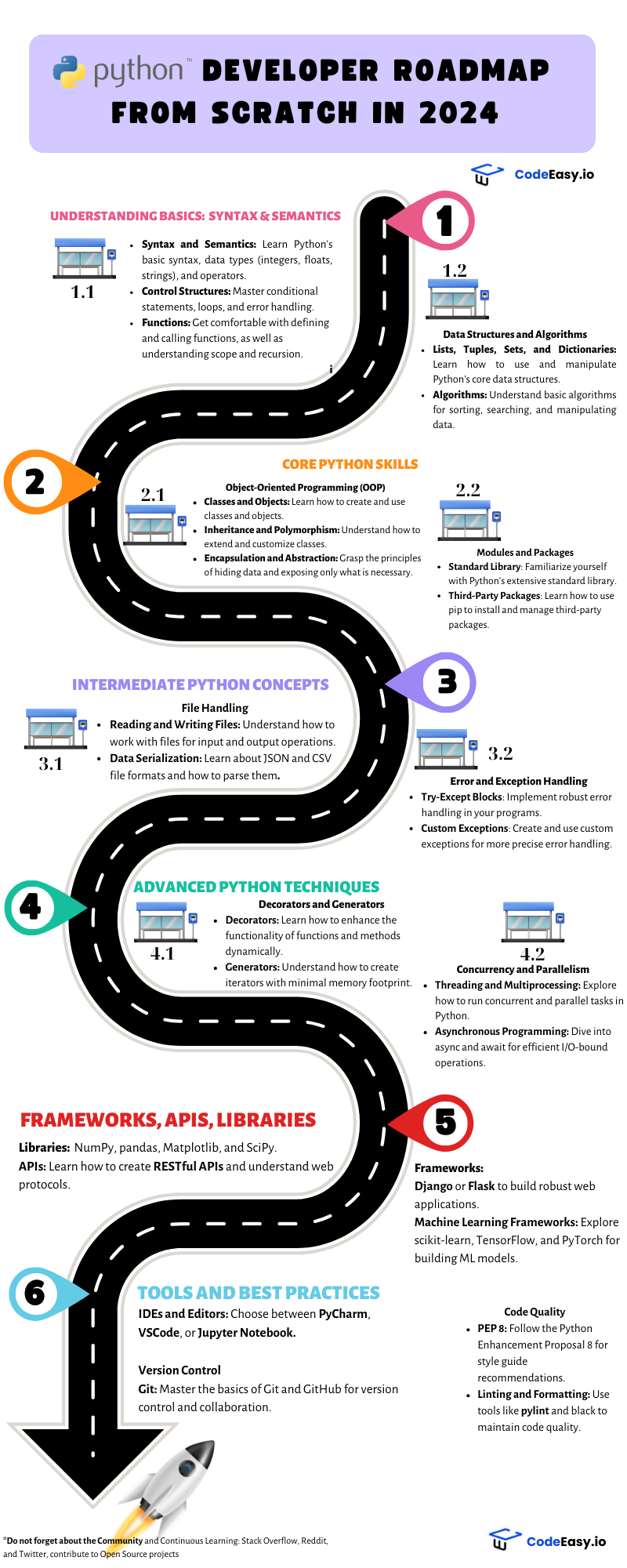Roadmap to Becoming a Python Developer from Scratch in 2024: A Beginner's Guide
Python continues to be one of the most popular and versatile programming languages in 2024. Its readability, simplicity, and vast ecosystem make it an excellent choice for beginners.
This comprehensive mini-roadmap will guide you through the steps to becoming a proficient Python developer, starting from scratch.

And now let's dive into details.
Step 1: Understanding the Basics
1.1 Learn Python Syntax and Semantics
- Variables and Data Types: Understand how to declare variables and use data types such as integers, floats, strings, and booleans.
- Basic Operations: Learn how to perform arithmetic operations, use comparison operators, and work with logical operators.
1.2 Control Structures
- Conditionals: Master if, elif, and else statements to control the flow of your programs.
- Loops: Get comfortable with for and while loops to iterate over data.
1.3 Functions
- Defining Functions: Learn how to define and call functions to organize your code.
- Parameters and Return Values: Understand how to pass parameters to functions and return values.
1.4 Basic Input and Output
- User Input: Learn how to take input from users using the input() function.
- Printing Output: Use the print() function to display information.
Step 2: Diving into Data Structures
2.1 Lists
- Creating and Accessing Lists: Understand how to create lists and access their elements.
- List Methods: Learn common list methods like append(), remove(), and sort().
2.2 Tuples
- Immutable Sequences: Learn how tuples differ from lists and how to use them.
2.3 Dictionaries
- Key-Value Pairs: Understand how to store and retrieve data using dictionaries.
2.4 Sets
- Unique Elements: Learn how to work with sets to store unique elements and perform set operations.
Step 3: Object-Oriented Programming (OOP)
3.1 Classes and Objects
- Defining Classes: Learn how to define classes and create objects.
- Attributes and Methods: Understand how to define attributes and methods within a class.
3.2 Inheritance
- Extending Classes: Learn how to create subclasses that inherit from parent classes.
3.3 Encapsulation and Abstraction
- Hiding Data: Understand how to encapsulate data and expose only necessary parts of a class.
Step 4: Working with Modules and Packages
4.1 Standard Library
- Using Built-in Modules: Get familiar with Python’s standard library and how to use built-in modules like math, datetime, and os.
4.2 Third-Party Packages
- Installing Packages: Learn how to install and manage third-party packages using pip.
- Popular Libraries: Explore popular libraries like requests for HTTP requests and BeautifulSoup for web scraping.
Step 5: Handling Files and Exceptions
5.1 File Handling
- Reading and Writing Files: Learn how to open, read, write, and close files in Python.
5.2 Exception Handling
- Try-Except Blocks: Understand how to handle errors gracefully using try, except, finally, and raise statements.
Step 6: Intermediate Python Concepts
6.1 List Comprehensions
- Concise List Creation: Learn how to create lists concisely using list comprehensions.
6.2 Generators and Iterators
- Efficient Iteration: Understand how to create and use generators for efficient iteration.
6.3 Decorators
- Enhancing Functions: Learn how to use decorators to modify the behavior of functions.
Step 7: Working with Databases
7.1 SQLite
- Database Operations: Learn how to perform CRUD (Create, Read, Update, Delete) operations using SQLite.
7.2 ORM with SQLAlchemy
- Object-Relational Mapping: Understand how to use SQLAlchemy to interact with databases in an object-oriented way.
Step 8: Web Development with Python
8.1 Flask
- Microframework: Learn the basics of web development using Flask, a lightweight web framework.
8.2 Django
- Full-Stack Framework: Explore Django for building robust, full-stack web applications.
Step 9: Data Science and Machine Learning
9.1 Data Analysis
- Pandas and NumPy: Learn how to use pandas and NumPy for data manipulation and analysis.
9.2 Data Visualization
- Matplotlib and Seaborn: Understand how to create visualizations using Matplotlib and Seaborn.
9.3 Machine Learning
- Scikit-Learn: Get started with machine learning by exploring Scikit-Learn for building and evaluating models.
Step 10: Version Control with Git
10.1 Basics of Git
- Repositories: Learn how to initialize and manage Git repositories.
- Commits and Branches: Understand how to make commits, create branches, and merge changes.
10.2 GitHub
- Collaboration: Learn how to use GitHub for version control and collaboration.
Step 11: Testing and Debugging
11.1 Unit Testing
- Unittest and Pytest: Learn how to write and run tests using Unittest and Pytest.
11.2 Debugging
- Debugging Tools: Understand how to use debugging tools and techniques to find and fix errors in your code.
Step 12: Advanced Topics and Continuous Learning
12.1 Asynchronous Programming
- Asyncio: Learn how to write asynchronous code using asyncio for concurrent execution.
12.2 Concurrency and Parallelism
- Threading and Multiprocessing: Explore threading and multiprocessing for parallel execution.
12.3 Continuous Learning
- Stay Updated: Follow Python blogs, join online communities, and participate in coding challenges to keep your skills sharp.
Conclusion
Becoming a Python developer from scratch in 2024 involves a step-by-step journey through various fundamental, intermediate, and advanced topics. By following this roadmap, beginners can systematically build their knowledge and skills, eventually mastering Python and unlocking numerous career opportunities. Remember, consistency and practice are key to success. Happy coding!


